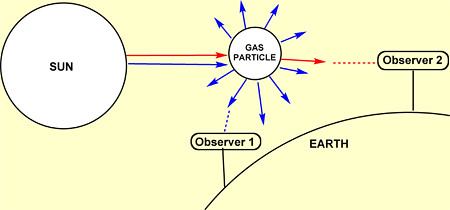Why the sky is blue?
We all can look up to the sky and see its beautiful blue colour. Why is it blue, and not red, or white for instance?

As I commented in the "Vegetables post", an object is coloured because of the light that it reflects. The white light from the sun contains all the wavelengths, but when it impacts on an object some of its wavelengths are absorbed and some reflected. For example blue objects reflect 'blue' light, which is light with a pretty short wavelength.
There is a phenomena named Rayleigh scattering, that consists on the scattering of light by particles much smaller than its wavelength. This effect is especially strong when light passes through gases.
Each of the wavelengths of light suffers a different scattering when it encounters the gas particles that form the atmosphere (nitrogen, oxygen...). This effect is more prominent in the case of short light wavelengths, that are the blue end of the visible spectrum, so the blue light becomes much more dispersed and it can be seen from every direction, as you can see in the drawing below. This gives us the impression that the sky is blue. On the other hand, the red colour is scattered much less, so it can be only seen from certain directions. In the drawing below, both Observer 1 and Observer 2 can see the blue light, but only Observer 2 is in the right direction to see the red one, and that's why we see those beautiful red skies at sunset sometimes.
There is a phenomena named Rayleigh scattering, that consists on the scattering of light by particles much smaller than its wavelength. This effect is especially strong when light passes through gases.
Each of the wavelengths of light suffers a different scattering when it encounters the gas particles that form the atmosphere (nitrogen, oxygen...). This effect is more prominent in the case of short light wavelengths, that are the blue end of the visible spectrum, so the blue light becomes much more dispersed and it can be seen from every direction, as you can see in the drawing below. This gives us the impression that the sky is blue. On the other hand, the red colour is scattered much less, so it can be only seen from certain directions. In the drawing below, both Observer 1 and Observer 2 can see the blue light, but only Observer 2 is in the right direction to see the red one, and that's why we see those beautiful red skies at sunset sometimes.

Then, why the clouds are white? Well, the water droplets that form the clouds have a much larger size than the gas particles of the air, and they scatter all the wavelenghts of light in the same extent, so all of them are reflected equally and we receive then the full colour of light, that is white.

No comments:
Post a Comment